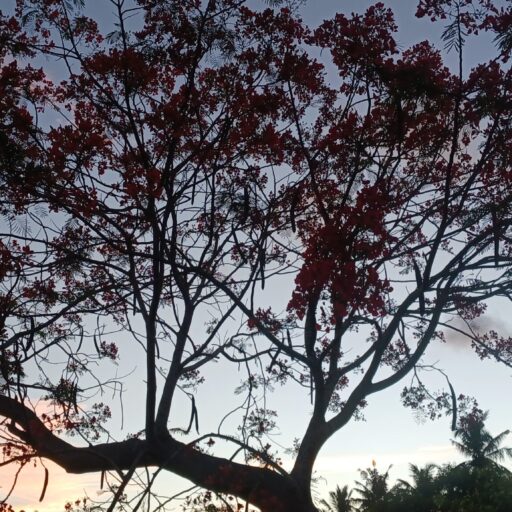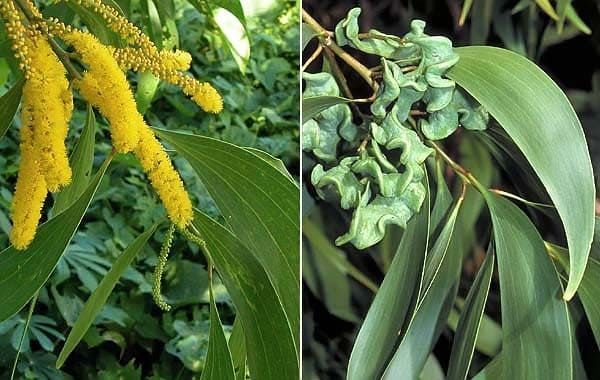Introduction
Acacia auriculiform is a fast-growing evergreen tree. It is an exotic fast growing tree species was introduced into southeast Asian countries on degraded soil. It is a medium sized evergreen tree with drooping branches. it has been widely introduced and cultivated in many tropical and sub-tropical region around the world. Like many Acacia species it has nitrogen fixing nodule on its roots, enriching the soil with nitrogen. It is often planted for its fast growth, valuable wood, and soil improvement properties. It is recommended for raising on fuel plantation. Its rapid early growth, even on infertile sites and tolerance of both highly acidic and alkaline soil make it popular for stabilizing and revegetating mines spoil. It has dense foliage with an open, spreading crown. It is used for shade and ornamental purposes in cities where its hardiness, dense foliage and bright yellow flowers are positive attributes. The spreading, superficial densely matted root system stabilizes eroding land. Roots are shallow and spreading. It’s dense crown of foliage that makes it an excellent choice for landscaping and reforestation project. The Acacia was widely cultivated by the then parks and recreation department. However, it was abandoned because of it generate considerable amount of leaf litter. By then it had already naturalized and is often a dominant species in young secondary forests. Because of its ability to survive inhospitable sites, it is much used in reclaiming wasteland areas, in conserving soil and water. It can also grow in soils with low fertility, making it suitable for reforestation and afforestation project in degraded area.
Native
It is Native to Australia, Papua New Guinea and Indonesia but has been widely introduced in other part of the world including southeast Asia, Africa, and South America
Common Name
Acacia, Earleaf Acacia, Australlian wattle, Earpod Wattle, Auri, Karuveli, Akashmani.
Tree height
The tree can grow up to 30Mtr tall
Stem
The trunk is crooked and the bark vertically fissured. The Bark of Acasia auriculiformis is smooth and greyish brown in color. As the tree mature the barks become rough and fissure.
Leaves
Leaves are alternate and simple slightly curved 5-8inch long and 1.5cm to 2.5cm wide with parallel nerves, thick and leathery. The leaves of acacia auriculiformis are actually modified leaf stalks (called phyllodes) which are flattened and enlarged. The true leaves bipinnately compounded are only visible on newly germinate seedling. Each leaflet is small, oblong and has a pointed tip. The leaf color is dark green.
Flower
Flowers are 8cm long in pairs and creamy yellow and sweet scented. Flowers in loose, yellow orange spikes at leaf axils or in cluster of spikes at stem tips. Typically flowering occurs during dry seasons.
Fruit
Pods are about 6.5cm x 1.5cm, flat, cartilaginous, glaucous, transversely veined with undulate margins. They are initially straight but on maturity becomes twisted with irregular spirals. Fruits a flat, oblong pod twisted at maturity.
Seed
Seeds are transversely held in the pod, broadly ovate to elliptical, about 4.6 x 3.4mm. The tree produces numerous small seeds usually after flowering. Seeds retain viability for several years.
Soil preference
The tree prefers well drained soil that is in rich organic matter. It can tolerate a wide range soil type including sandy, loamy and clay soils. It exhibits the ability to grow in a variety of soil including sands and black cracking clays, seasonally waterlogged soils, sandy loams and coral rag. It can also grow alkaline to saline soils, pH ranging between 4.3 and 9.
Watering
The tree requires regular watering during the growing season, especially during hot and dry weather. Make sure the soil is moist but not waterlogged.
Sun requirements
Acacia Auriculiformis is a light demanding species and require full sunlight for optimal growth but can tolerate partial shade. Make sure at least 6 hours of direct sunlight per day.
Pruning
Prun the young tree to promote a desirable shape and remove any dead or diseased branches. Removal of lower branches and of young plants has been suggested as a mean of improving stem form and of reducing the incidence of multiple stems. Regular pruning can also help maintain the overall health and vigor the tree.
Propagation
It can be raised easily from seed. Which germinate readily. Seeds must be soaked in water for 24 to 36 hours before sowing in the field or the nursery. But for ensuring success and better growth, transplanting of nursery raised seedling always preferred. The optimum size of the seedling for transplanting is 20 to 30cm.
Nursery
Collection of mature seeds from healthy and vigorous trees. There are approximately 55000-75000 seeds per kg. The hard outercoat of the seeds can be scarified by mechanical means or by soaking them hot water to enhance germination. Pre-sowing treatments can also be applied to improve germination. Prepare a well-drained nursery bed with fertile soil. Ensure that the nursery bed receives adequate sunlight for optimal growth. Sow treated seed in rows or in seed trays ensuring proper spacing between them. Cover the seeds with a thin layer of soil and gently press them down. Water the nursery bed regularly to keep the soil moist but not waterlogged. Protect the seedling from the extreme weather condition and pests. When seedling reach a height of 15-20cm they can be transplanted to their permanent location. Choose a site with well-drained soil and adequate sunlight for optimal growth. Regular weeding to minimize competition for nutrients and water. Use of herbicide or manual removal of weeds. Mulching at the base of the tree to suppress weed growth. Seedling can be hardened before transplanting, increasing survival rate.
General uses
Under favorable conditions trees may reach a height of 15m in 5 years and produce an annual wood increment of 15-20Cum/ha over 10-12 years. A major source of firewood, its dense wood and high energy (caloric value 4500-4900Kcal/Kg contribute to its popularity. The wood has a high basic density(500-650kg/m2) is fine grained, often attractively figured and finishing well. It is used for construction if trees of suitable girth are available. In India the bark is collected locally for use as tanning material. The flowers are a source of pollen for honey production. The wood is extensively used for paper pulp. The flower are a source of pollen for honey production. It is a major source of firewood and provide good charcoal that glow well with little smoke and does not spar. In other Southeast Asian countries, they are planted to produce wood for furniture.
Pests and Disease
Acacia Auriculiformis is relatively resistant to pest and diseases, but it can still suffer from some common problem. Here are some of the most common pests and diseases that affect the tree. The tree susceptible to attack by termite which can cause significant damage to the trunk and root. The tree can be infested by caterpillar, which can be defoliate the tree if left untreated. Monitor the tree regularly for any sign of pests or diseases. Take appropriate measure such as using insecticide and fungicide to control and prevent infestations.
Classification
Kingdom:-Plantae
Phylum:- Spermatophyta
Class:- Magnoliopsida
Family:- Fabaceae
Genus:- Acacia
Species:-Acasia auriculiformis
FAQ (Frequently Asked Questions)
- Is acacia Auriculiformis is a good choice for landscaping?
Yes, Acacia Auriculiformis is an excellent choice for land scaping due to its first growth, dense foliage and attractive appearance.
2. Can Acacia Auriculiformis tolerate drought?
Yes, Acacia can tolerate drought, but it requires regular watering during the growing season to thrive.
3. Does Acacia attract bees?
Yes, acacia produces flowers that are attractive to bees and other pollinators.

